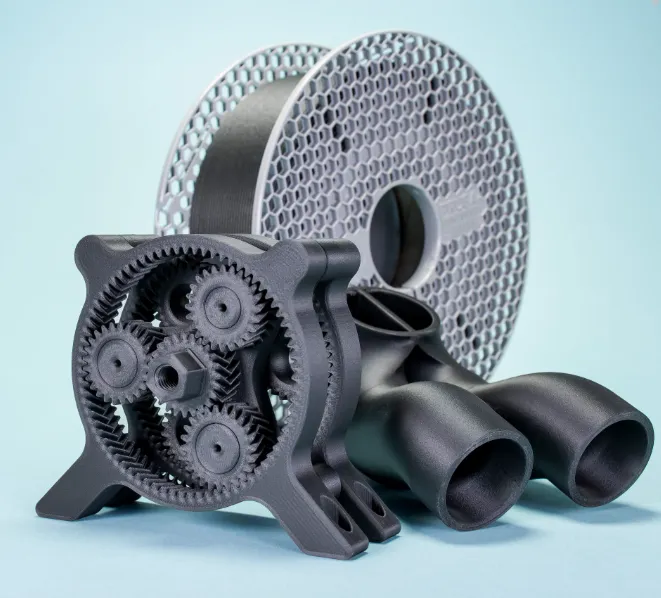In recent years, 3D printing has revolutionized industries from healthcare to aerospace, enabling new levels of innovation. Among the most exciting developments is the incorporation of carbon fiber into 3D printing. This powerful material offers significant advantages, making it a game-changer for manufacturing processes. But what exactly is carbon fiber, and why is it becoming so popular in 3D printing? Let’s dive in.
What is Carbon Fiber?
Carbon fiber is a lightweight yet incredibly strong material made from thin strands of carbon atoms bonded together in a pattern. It’s renowned for its strength-to-weight ratio, thermal resistance, and durability, making it ideal for industries where these qualities are essential. Its applications span across sectors such as aerospace, automotive, sports, and even medical research.
Industries Embracing Carbon Fiber
Due to its impressive properties, carbon fiber is used in a variety of industries:
- Aerospace: Airplanes benefit from carbon fiber’s ability to reduce weight, with some aircraft components losing up to 20% of their mass through its use.
- Automotive: High-performance race cars rely on carbon fiber for its combination of lightness and strength, providing an edge in competitive racing.
- Sports Equipment: Carbon fiber is commonly found in bicycles, fishing rods, skis, and tennis rackets due to its light weight and resilience.
- Medical Devices: Carbon fiber’s biocompatibility makes it an excellent choice for prosthetics and dental implants.
- Robotics: Lightweight, heat-resistant carbon fiber tools are used in assembly-line robotics for enhanced precision and strength.
The Advantages and Drawbacks of Carbon Fiber
Like any material, carbon fiber has both pros and cons:
Pros:
- Strength: Its tensile strength outperforms many metals, including steel and titanium.
- Lightweight: Ideal for applications requiring reduced weight without sacrificing strength.
- Corrosion Resistance: Carbon fiber doesn’t corrode, making it perfect for outdoor use.
- Thermal Stability: It has low thermal expansion, meaning its shape remains stable even in extreme temperatures.
Cons:
- Cost: It’s considerably more expensive than alternative materials like steel or plastic.
- Brittleness: While strong, carbon fiber can be brittle and prone to cracking or shattering upon impact.
- Difficult to Work With: The complex nature of carbon fiber makes it harder to shape and manipulate compared to other materials.
- Environmental Concerns: Recycling carbon fiber is challenging, which can raise sustainability issues.
Why Use Carbon Fiber in 3D Printing?
With a growing selection of 3D printing materials available, you may wonder: why choose carbon fiber? The answer lies in its exceptional strength, lightness, and performance in high-precision applications. Unlike traditional materials like ABS or PLA, carbon fiber offers superior mechanical properties, making it the preferred choice for many demanding tasks, from prototype development to custom parts manufacturing.
For instance, ABS, though popular for 3D printing, is heavier and more prone to expansion under heat, which makes it less ideal for high-performance sectors like aerospace or medical fields. Carbon fiber, on the other hand, offers greater durability and is biocompatible, adding value in industries where these qualities are crucial.
What is Carbon Fiber 3D Printing?
In essence, carbon fiber 3D printing refers to the use of carbon fiber-infused filaments in the additive manufacturing process. However, the technology itself is more nuanced. Various methods and materials are available, each suited to different applications.
Popular 3D Carbon Fiber Printing Methods
Several techniques are commonly used for 3D printing with carbon fiber:
- Fused Deposition Modeling (FDM): This method uses a carbon fiber-infused filament that is melted and extruded through a heated nozzle. It’s a cost-effective method for producing strong, lightweight parts but can result in weaker strength between layers.
- Continuous Filament Fabrication (CFF): This process uses two nozzles to extrude both a thermoplastic filament and continuous carbon fibers. It produces parts with greater tensile strength than FDM, making it suitable for structural components.
- Selective Laser Sintering (SLS): SLS employs a laser to fuse powdered carbon fiber-infused plastic into 3D objects. It excels in producing complex geometries and high-quality surface finishes, though it’s typically the most expensive option.
Choosing the Right Carbon Fiber 3D Printing Method
The choice of method depends on various factors, such as budget, project requirements, and material availability. Below is a quick comparison of the three main methods:
| Method | Material | Strength | Surface Finish | Cost & Speed | Ideal Uses |
|---|---|---|---|---|---|
| FDM | Chopped carbon fiber infused thermoplastics | Good strength in extrusion direction, weaker between layers | Low quality | Fast and cost-effective | Prototypes, tooling, large parts |
| CFF | Continuous carbon fiber filament | Stronger than FDM due to continuous fibers | Moderate quality | Similar to FDM, higher material costs | Structural components, high-strength parts |
| SLS | Polymer powder infused with carbon fiber | Isotropic strength, strong in all directions | High quality, handles complex shapes | High cost, moderate speed | Complex geometries, detailed parts |
Conclusion
As 3D printing continues to evolve, carbon fiber is emerging as a leading material due to its unmatched strength, lightweight nature, and versatility. Whether you’re looking to prototype a new product or manufacture high-performance parts, carbon fiber 3D printing provides an advanced solution that outperforms traditional manufacturing methods in many ways. If you’re ready to take your designs to the next level, embracing this technology could be the key to unlocking new possibilities.







